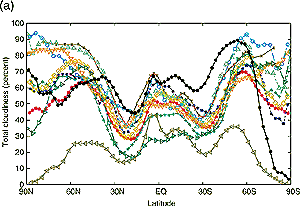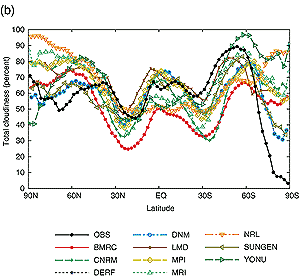8.5.1.2.2 Surface and top of atmosphere (TOA) fluxes


Figure 8.7: Zonally averaged December-January-February total cloudiness
simulated by ten AMIP1 models (a) and by revised versions of the same ten
models (b). The solid black line gives observed data from the International
Satellite Cloud Climatology Project (ISCCP). From Gates et al. (1999). |
In this and the following two sub-sections we discuss simulations
by AGCMs that are provided observed sea surface temperatures and sea-ice distributions
as input boundary conditions. AOGCM control runs have not yet been thoroughly
examined in studies of surface boundary fluxes or mid-tropospheric and stratospheric
quantities.
Satellite observations over the past quarter of a century have provided estimates
of top of atmosphere (TOA) flux that are considered reliable. Any discrepancies
between models and observations are usually attributed to the inadequate modelling
of clouds, since they are difficult to specify and accurately model, and account
for most of the variability.
Unfortunately, there are no global estimates of surface flux that do not rely
heavily on models. The best model-independent estimates come from the Global
Energy Balance Archive (GEBA), a compilation of observations from more than
1,000 stations (Gilgen et al., 1998). Compared with GEBA observations, surface
solar insolation is overestimated in most AGCMs (Betts et al., 1993; Garratt,
1994; Wild et al., 1997, 1998; Garratt et al., 1998). Downwelling long wave
radiation, on the other hand, is underestimated (Garratt and Prata, 1996; Wild
et al., 1997). The shortwave discrepancy is of more concern: it is more than
a factor of two larger than the long-wave discrepancy, and could be due to missing
absorption processes in the atmosphere.
The observations indicate that about 25% of the incident solar flux at the
TOA is absorbed in the atmosphere, but most models underestimate this quantity
by 5 to 8% of the of the incident solar flux (Arking, 1996, 1999; Li et al.,
1997). The extent and the source (or sources) of this discrepancy have been
intensely debated over the past five years, with investigations yielding contradictory
results on whether the discrepancy is associated with clouds, aerosols, water
vapour, or is an artefact of the instrumentation and/or the methods by which
sensors are calibrated and deployed.
This discrepancy is important for climate modelling because it affects the
partitioning of solar energy between the atmosphere and the surface. If the
observations are correct, then improving the models will reduce the energy available
for surface evaporation by 10 to 20% with a corresponding reduction in precipitation
(Kiehl et al., 1995) and a general weakening of the hydrological cycle.
8.5.1.2.3 Mid-tropospheric variables
The SAR concluded that although atmospheric models adequately simulate the
three-dimensional temperature distribution and wind patterns, “current
models portray the large-scale latitudinal structure and seasonal change of
the observed total cloud cover with only fair accuracy”. Subsequent studies
have confirmed both the good and bad aspects of model simulations. Throughout
most of the troposphere, errors in AMIP1 ensemble simulations of temperature
and zonal wind are small compared with either inter-model scatter or the observed
spatial standard deviation (Gates et al., 1999). (See Section
8.8 for brief discussion of storm tracks.) On the other hand, discrepancies
between models and observations that substantially exceed the observational
uncertainty are evident for both clouds (Mokhov and Love, 1995; Weare et al.,
1995, 1996; Weare, 2000a, 2000b) and upper tropospheric humidity (see Chapter
7).
Although solutions to these problems have proved elusive, incremental improvements
have been noted since publication of the SAR. For total cloudiness, a revised
subset of AMIP models exhibits noticeably less inter-model variation and significantly
less average r.m.s error (Gates et al., 1999; Figure 8.7),
compared with the original versions of the models. Several models adequately
simulate seasonal changes in cloud radiative forcing (Cess et al., 1997). Model
intercomparisons organised under the Global Energy and Water cycle Experiment
(GEWEX) Cloud System Study (Stewart et al., 1998) will provide further information
for improving cloud simulation. For tropospheric humidity, improved agreement
with observations may result from improved numerical techniques (Section
8.9). Furthermore, even though the seasonal mean amounts of clouds and upper
tropospheric water vapour are not well simulated in current climate models,
variations of these quantities may be more important than absolute amounts for
predicting climate changes. For example, Del Genio et al. (1994) noted that,
in mid-latitudes, the seasonal cycle of upper tropospheric humidity can be simulated
reasonably well by climate models. They argued that this variation provides
a surrogate for decadal climate change in mid-latitudes because both are characterised
by combined temperature increase and latitudinal temperature-gradient decrease,
and thus both have similar effects on storms.
Examination of monsoons in climate models provides another measure of their
ability to simulate hydrologic variations. Developments since publication of
the SAR have been encouraging. Sperber and Palmer (1996) found that about half
the original AMIP models obtained a realistic dependence of monsoon circulation
on location and season. A follow-up study reveals that nearly all the revised
AMIP models do so (Sperber et al., 1999; see Section 8.7.3).

